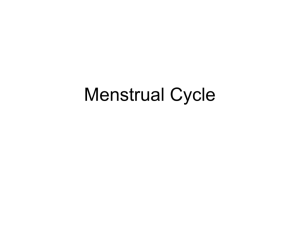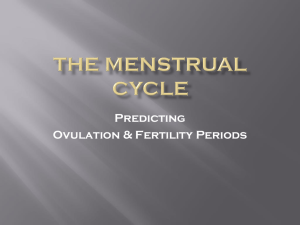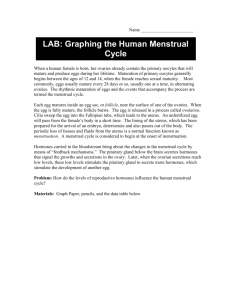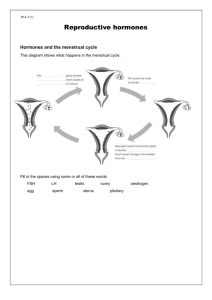Menstrual cycle - Lesson element (DOC, 2MB) New 03/05/2016
advertisement
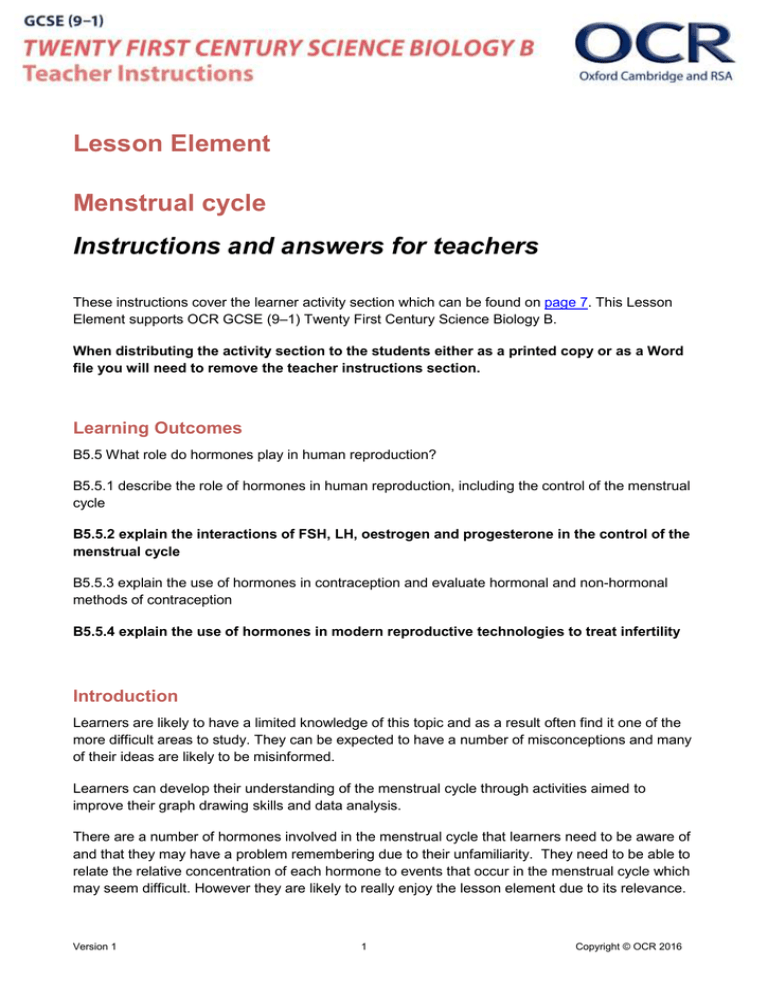
Lesson Element Menstrual cycle Instructions and answers for teachers These instructions cover the learner activity section which can be found on page 7. This Lesson Element supports OCR GCSE (9–1) Twenty First Century Science Biology B. When distributing the activity section to the students either as a printed copy or as a Word file you will need to remove the teacher instructions section. Learning Outcomes B5.5 What role do hormones play in human reproduction? B5.5.1 describe the role of hormones in human reproduction, including the control of the menstrual cycle B5.5.2 explain the interactions of FSH, LH, oestrogen and progesterone in the control of the menstrual cycle B5.5.3 explain the use of hormones in contraception and evaluate hormonal and non-hormonal methods of contraception B5.5.4 explain the use of hormones in modern reproductive technologies to treat infertility Introduction Learners are likely to have a limited knowledge of this topic and as a result often find it one of the more difficult areas to study. They can be expected to have a number of misconceptions and many of their ideas are likely to be misinformed. Learners can develop their understanding of the menstrual cycle through activities aimed to improve their graph drawing skills and data analysis. There are a number of hormones involved in the menstrual cycle that learners need to be aware of and that they may have a problem remembering due to their unfamiliarity. They need to be able to relate the relative concentration of each hormone to events that occur in the menstrual cycle which may seem difficult. However they are likely to really enjoy the lesson element due to its relevance. Version 1 1 Copyright © OCR 2016 Teacher preparation Learners are required to use the data in Task 1 to plot the relative hormones concentrations on to graph paper. This will produce a chart that shows the hormone concentrations and formation of the uterine lining over a 28 day period. Learners can then progress onto Task 2. Here learners cut out the activity cards and then organise them end-to-end so that the question on the bottom of one card is answered by the answer on the top of the next card. The final activity requires allows learners to consolidate their understanding along with developing their learning further. The following resources can be used by learners either prior to the lesson or as consolidation. https://www.youtube.com/watch?v=pNe43KGZTl8 http://www.abpischools.org.uk/page/modules/hormones/horm4.cfm http://www.nhs.uk/video/pages/menstrualcycleanimation.aspx Prior knowledge Learners should be able to recall that reproduction in humans includes the structure and function of the male and female reproductive systems, along with details of gametes and fertilisation. Although learners will have studied the menstrual cycle, this was without details of the hormones involved in the cycle. Version 1 2 Copyright © OCR 2016 Relative Concentration Task 1 Day Version 1 3 Copyright © OCR 2016 Task 2 This activity can be used in pairs or as a plenary for the session. The answers are in order going down column 1 then column 2, column 3 and column 4. The answer on the first card in column 1 answers the question at the end of column 4. Lining of uterus breaks down Fall Progesterone Fertilisation The lining of the uterus breaks down over how many days? A decrease in oestrogen levels at day 10 causes an increase in which two hormones? How long does progesterone take to reach its peak? What is it called when the female no longer has a menstrual cycle? 5 FSH and LH 3 days Menopause The breakdown of the uterus lining is known as what? What happens when LH and FSH levels peak? What is the role of progesterone? At what age does the menopause happen? A period Ovulation occurs Increase / maintain the thickness of the uterine lining Approximately 50-55 A female cannot get pregnant on her period. True or False? For ovulation to occur what must have happened? What does the lining of the uterus contain lots of? Does the cycle take the same amount of time each month, Yes or No? False The egg must mature Blood vessels No Oestrogen levels peak on what day? What day does ovulation occur on? What do the blood vessels supply to the egg cell? How long does the menstrual cycle take? 10 14 Glucose and oxygen 28 days What happens to oestrogen levels after day 10? What hormone begins to increase after day 14? What is it called when a sperm cell meets an egg cell? What happens if the egg has not been fertilised? Version 1 4 © OCR 2016 Task 3 – Extension questions 1. State the 4 hormones involved in the menstrual cycle 1. FSH 2. LH 3. Oestrogen 4. Progesterone 2. What is meant by the term ovulation? Release of an egg cell from one of the ovaries. 3. Which two hormones peak when ovulation occurs? 1. FSH 2. LH 4. For each of the statements below state if they are true or false 1 A menstrual cycle lasts exactly 28 days. TRUE / FALSE 2 Mitosis causes the uterine lining to get thicker. TRUE / FALSE 3 A period is when the uterine lining breaks down. TRUE / FALSE 4 A period results in heavy bleeding. TRUE / FALSE 5 If a sperm cell and egg cell combine this is known as fertilisation. TRUE / FALSE 6 A pregnancy cannot occur during the period. TRUE / FALSE 5. Sperm cells contain many mitochondria to allow them to swim. State the type of respiration that occurs inside sperm cells and the symbol equation for this type of respiration? Aerobic respiration. C6H12O6 + 6O2 Version 1 6CO2 + 6H2O 5 © OCR 2016 6. State the name of the type of cell division that results in the formation of sex cells such as sperm cells and egg cells. Meiosis 7. Females produce all their egg cells before birth. Menopause is when ovulation of those egg cells stops. If a female starts her menstrual cycle at a young age how is it likely to affect when she will go through the menopause? She would be more likely to go through the menopause at a younger age. We’d like to know your view on the resources we produce. By clicking on ‘Like’ or ‘Dislike’ you can help us to ensure that our resources work for you. When the email template pops up please add additional comments if you wish and then just click ‘Send’. Thank you. If you do not currently offer this OCR qualification but would like to do so, please complete the Expression of Interest Form which can be found here: www.ocr.org.uk/expression-of-interest OCR Resources: the small print OCR’s resources are provided to support the teaching of OCR specifications, but in no way constitute an endorsed teaching method that is required by the Board, and the decision to use them lies with the individual teacher. Whilst every effort is made to ensure the accuracy of the content, OCR cannot be held responsible for any errors or omissions within these resources. © OCR 2016 - This resource may be freely copied and distributed, as long as the OCR logo and this message remain intact and OCR is acknowledged as the originator of this work. OCR acknowledges the use of the following content: Page 3 & 9 menstrual cycle: Britannica.com/Encyclopaedia Britannica Please get in touch if you want to discuss the accessibility of resources we offer to support delivery of our qualifications: resources.feedback@ocr.org.uk Version 1 6 © OCR 2016 Lesson Element Menstrual cycle Learner Activity Task 1 The menstrual cycle is a hormone controlled process that takes approximately 28 days. It is essential for sexual reproduction. Around day 14 is when ovulation occurs. Following ovulation, the lining of the uterus thickens, ready for the fertilised egg to implant. If the ovum is not fertilised the thickened lining breaks down and the female has a period. Using the data on the next page, plot the relative concentration of each hormone on the chart. Use a different colour for each hormone. Version 1 7 © OCR 2016 Relative concentration Day Version 1 FSH LH Oestrogen Progesterone 1 2 1.5 1 1 2 2 1.5 1 1 3 2 1.5 1 1 4 1.5 1 1 1 5 1 1 2 1 6 1 1 4 1 7 1 1 6 1 8 1 1 7.5 1 9 1 1 8 1 10 1 1.5 8.5 1 11 1 2 8 1 12 2 3 7 1 13 3.5 5 5 1 14 5 10 5 1 15 4 5 6 2 16 2.5 3 6.5 5 17 1.5 2 6.5 8 18 1 1.5 6.5 8 19 1 1 6.5 8 20 1 1 6.5 8 21 1 1 6.5 8 22 1 1 6.5 8 23 1 1 6.5 8 24 1 1 6.5 8 25 1 1 6 8 26 1 1 5 5 27 1 1 3 2 28 2 1 1 1 8 © OCR 2016 10 9 8 Relative Concentration 7 6 5 4 3 2 1 0 1 2 3 4 5 6 7 8 9 10 11 12 13 14 15 16 17 18 19 20 21 22 23 24 25 26 27 28 Day Version 1 9 © OCR 2016 Task 2 Cut the cards out along the bold lines. Place the cards end to end so the top of the card is the answer to a previous question. Use your graph from Task 1 to help you. FSH and LH Lining of uterus breaks down Approximately 50-55 3 days What happens when LH and FSH levels peak? The lining of the uterus breaks down over how many days? Does the cycle take the same amount of time each month, Yes or No? What is the role of progesterone? The egg must mature False Progesterone No What day does ovulation occur on? Oestrogen levels peak on what day? How long does progesterone take to reach its peak? How long does the menstrual cycle take? A period 5 14 Glucose and oxygen A female cannot get pregnant on her period. True or False? The breakdown of the uterus lining is known as what? What hormone begins to increase after day 14? What is it called when a sperm cell meets an egg cell? Blood vessels Increase / maintain the thickness of the uterine lining Ovulation occurs Menopause What do the blood vessels supply to the egg cell? What does the lining of the uterus contain lots of? For ovulation to occur what must have happened? At what age does the menopause happen? Fall 28 days 10 Fertilisation A decrease in oestrogen levels at day 10 causes an increase which in two hormones? What happens if the egg has not been fertilised? What happens to oestrogen levels after day 10? What is it called when the female no longer has a menstrual cycle? Version 10 © OCR 2016 Task 3 – Extension questions 1. State the 4 hormones involved in the menstrual cycle 1. 2. 3. 4. 2. What is meant by the term ovulation? 3. Which two hormones peak when ovulation occurs? 1. 2. 4. For each of the statements below state if they are true or false Version 1 A menstrual cycle lasts exactly 28 days. TRUE / FALSE 2 Mitosis causes the uterine lining to get thicker. TRUE / FALSE 3 A period is when the uterine lining breaks down. TRUE / FALSE 4 A period results in heavy bleeding. TRUE / FALSE 5 If a sperm cell and egg cell combine this is known as fertilisation. TRUE / FALSE 6 A pregnancy cannot occur during the period. TRUE / FALSE 11 © OCR 2016 5. Sperm cells contain many mitochondria to allow them to swim. State the type of respiration that occurs inside sperm cells and the symbol equation for this type of respiration? 6. State the name of the type of cell division that results in the formation of sex cells such as sperm cells and egg cells. 7. Females produce all their egg cells before birth. Menopause is when ovulation of those egg cells stops. If a female starts her menstrual cycle at a young age how is it likely to affect when she will go through the menopause? Version 12 © OCR 2016
